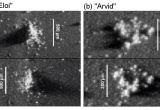Cometary aggregates observed by the COSISOPE camera of the COSIMA instrument close to comet Churyumov-Gerasimenko
Since the rendezvous of the Rosetta spacecraft with comet Churyumov-Gerasimenko in early August 2014, its COSIMA instrument has exposed targets for collecting cometary grains. The results have much exceeded expectations, with collected particles up to several 100 µm, including many aggregates. For the first time, cometary grains are collected at a low velocity (<10 m/s) and close to the nucleus, making it possible to characterize these particles a few hours only after they left the nucleus.
COSIMA is a time-of-flight mass spectrometer under German responsibility (MPS Göttingen). It includes a microscope (COSISCOPE), developed at IAS, in charge of detecting collected grains by comparing images before and after exposure.
Many collected particles have broken up upon collection, and they have a “fluffy” aspect indicating a high porosity. These particles, rich in Sodium (Na), originate from the dust mantle accumulated on the surface of the comet since the last close approach to the Sun. The dust particles observed by COSISCOPE are similar to Interplanetary Dust Particles (IDP’s), which are also aggregates, down to scales smaller than the COSISCOPE pixel (14 µm). These observations strengthen the view that most IDP’s originate from comets. The results have been published in Nature (26 January 2015), and the article has been highlighted by a “press alert” from CNRS.
 Two dust particles with a complex structure collected by COSIMA and observed by COSISCOPE. The images have been obtained with two grazing incidence illuminations, from the right (top row) and from the left (bottom row). Panel (a) shows a dust particle which crumbled into a rubble pile upon collection (the grains have each been given a name by the COSIMA team, here “Eloi”). Panel (b) exhibits a dust particle (“Arvid”) which fragmented when hitting the target. Eloi is approximately 400 µm in size while Arvid is approximately 300 µm in size.
Two dust particles with a complex structure collected by COSIMA and observed by COSISCOPE. The images have been obtained with two grazing incidence illuminations, from the right (top row) and from the left (bottom row). Panel (a) shows a dust particle which crumbled into a rubble pile upon collection (the grains have each been given a name by the COSIMA team, here “Eloi”). Panel (b) exhibits a dust particle (“Arvid”) which fragmented when hitting the target. Eloi is approximately 400 µm in size while Arvid is approximately 300 µm in size.Contact at IAS : Yves Langevin / 01 69 85 86 81 / 06 80 74 99 83 / yves.langevin @ ias.u-psud.fr
Links :
CNRS press release :
Article : http://www.nature.com/nature/journal/vaop/ncurrent/full/nature14159.html




